Doing a keyword gap analysis is a key step in gaining market share from competitors.
Unlike many other marketing practices, SEO provides highly accurate data on competitors.
Once you identify valuable keywords your competitors are ranking for, you can act to get that traffic for your own business.
This tutorial will show you how to do a keyword gap analysis. And we’ll share our unique approach to this.
In This Article
What is Keyword Gap Analysis?
A keyword gap analysis identifies keywords that your competitors are ranking for, but you aren’t. And it reveals competitors’ top-ranking keywords that your site ranks lower for.
The goal is to create content (or improve existing content) on those keywords to outrank competitors and gain market share.
Not all keywords are worth winning, though. So, we’ll share how you can identify valuable keyword opportunities for your business.
Benefits of Keyword Gap Analysis
Keyword gap analysis provides a view into your competitors’ SEO strategies, you can use that data to gain a competitive advantage.
Specifically, analyzing the keyword gap provides the groundwork for a strategic approach to content creation. Taking this approach, you can rank higher in organic search results while gaining market share or mindshare from competitors.
To do this, you’ll create content that usurps competitors’ rankings.
But even if you come in 1-3 slots below them, you can capture prospects that would otherwise go to another competitor. And that’s progress.
Before we get into the how-to of keyword gap analysis, here are 2 things to remember.
Preparation: 2 Things to Know About Keywords
Understanding the following aspects of keywords will help you choose the best ones to create content on.
Let’s start with keyword difficulty.
1. Keyword Difficulty Scores
You may have noticed that some keywords are nearly impossible to rank for, while others are easy to land a #1 spot for.
It all comes down to the amount and nature of the competition for those keywords.
This concept is easy to understand when compared to an athletic competition. Imagine you’re an amateur runner, and you can choose which races you compete in.
If you’re new at racing, would you choose to race against Usain Bolt, the Olympian world record holder? Or would you start by competing against amateur runners like yourself? Probably the latter.
We all want to participate in competitions that we have a chance of winning. It’s the same in SEO.
Thankfully, keyword research tools like Semrush and Ahrefs help us pick the right keywords to compete against.
Specifically, these SEO tools provide a Keyword Difficulty score for each keyword. Along with a score, these tools label keywords as “Very hard,” “Hard,” “Possible,” “Easy,” or “Very easy.”
Choose keywords that are easy to rank for.
“But,” you say, “I don’t want to rank for just any keywords.”
Yes, exactly! You want to choose “Possible” or “Easy” keywords worth ranking for.
And that brings us to keyword intent.
2. Keyword Intent
Those software tools we mentioned, Semrush and Arhefs, label keywords according to intent.
By “intent,” we mean it’s possible to discern whether or not a searcher has any buying intent when they use a particular search term.
For instance, which keywords indicate the searcher is looking to buy soon?
- Insurance
- Car insurance
- Cheap car insurance quotes no deposit
Broad keywords (like “flooring ideas”) tend to be labeled “Informational” because the searcher is doing basic research. Their intent is often vague.
As keywords become more specific (“Brazilian teak hardwood flooring”), the intent becomes clearer and often is commercial.
A searcher with buying intent may be comparing products (“Geico vs. Progressive” or “best budget leaf blowers”) or may be on the brink of buying (“book Bahamas cruise”).
Keyword research tools designate intent with letters.
- I is for Informational: The searcher is gathering general information. They have no buying intent.
- N is for Navigational: the intent is to find a particular product or website (e.g., “Walmart auto service”)
- C is for Commercial: the searcher compares products, services, and prices. They’re deciding which item to buy. These searchers may also look for “How to” content because they have a problem to solve.
- T is for Transactional: the searcher is ready to buy now.
Choosing the best keywords: An ideal content strategy will focus primarily on long-tail keywords with a low difficulty score and commercial or transactional intent. Keep in mind that informational keywords are often broad and difficult to rank for. And often, the content doesn’t convert as well.
How to Do a Keyword Gap Analysis
For our tutorial, we’ll be using Semrush, a popular keyword software platform.
Semrush includes a keyword gap analysis tool that’s easy for novices to use.
Step 1: Create a Semrush Account
First, create a Semrush account.
You can sign up for a 7-day free trial and can cancel anytime.
Step 2: Navigate to Keyword Gap
Next, in the left-hand navigation column of Semrush, click on Keyword Gap.
Step 3: Add Competitor
Then, enter your website URL in the topmost field.
Then, add 1-4 competitor URLs.
Rei.com vs. PublicLands.com
For our example, we’ll use REI.com, a popular sporting goods store focusing on outdoor recreation products like hiking boots, kayaks, and rock climbing gear.
For our competitor, we’ll choose PublicLands.com, a subsidiary belonging to another competitor: Dick’s Sporting Goods.

Like REI.com, PublicLands.com focuses on gear for outdoor adventures.
We want to find keywords that PublicLands.com is ranking for, but REI isn’t.
Because REI is an established brand, we’re not too concerned about keyword difficulty. Nevertheless, we can prioritize those that are easy to rank for.
Click the Compare button to get started with the keyword gap analysis.
Now, you’ll see a Keyword Overlap chart. This gives you a quick sense of how many keywords REI.com ranks for (1.3 million) and how many the competitor, PublicLands.com, ranks for (over 121k).
And you can see there’s overlap between the brands.
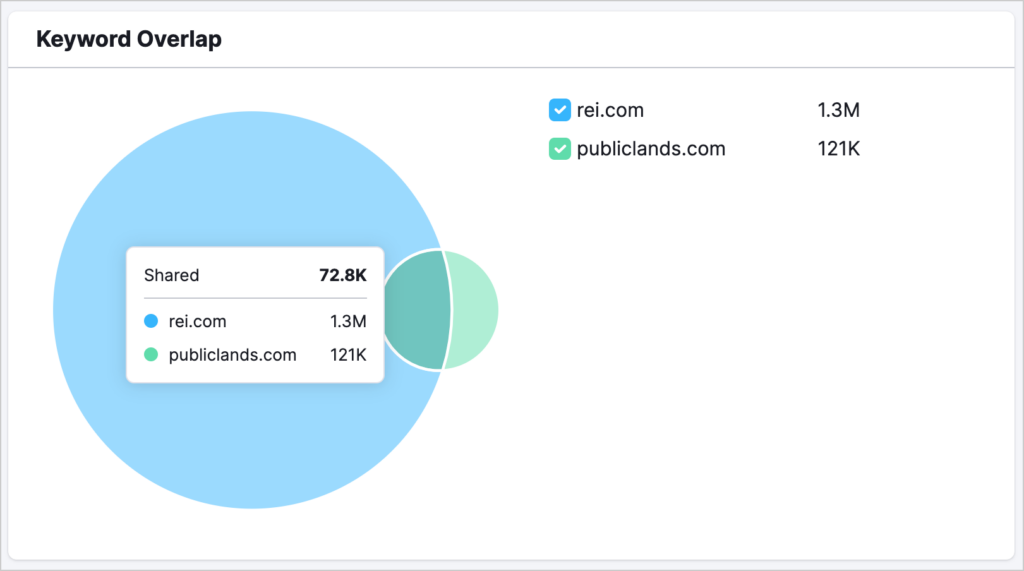
Step 4: Choose Your Filters
Next, we’ll filter our results so we only get keywords that are easy to rank for and signal commercial or transactional intent.
Above the Keyword Overlap chart, you’ll find clickable filters.
Filter By Intent
- Click on the Intent filter.
- Tick the boxes next to Commercial and Transactional.
- Then click Apply.
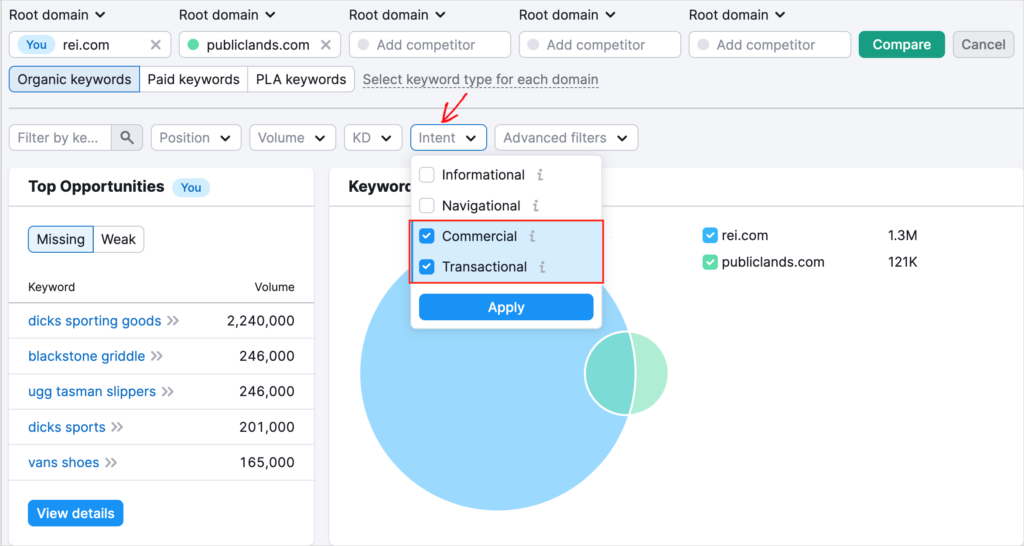
Filter by KD (Keyword Difficulty Score)
- Next, click on the KD filter.
- Select “Easy” or “Very easy.”
- Then click Apply.
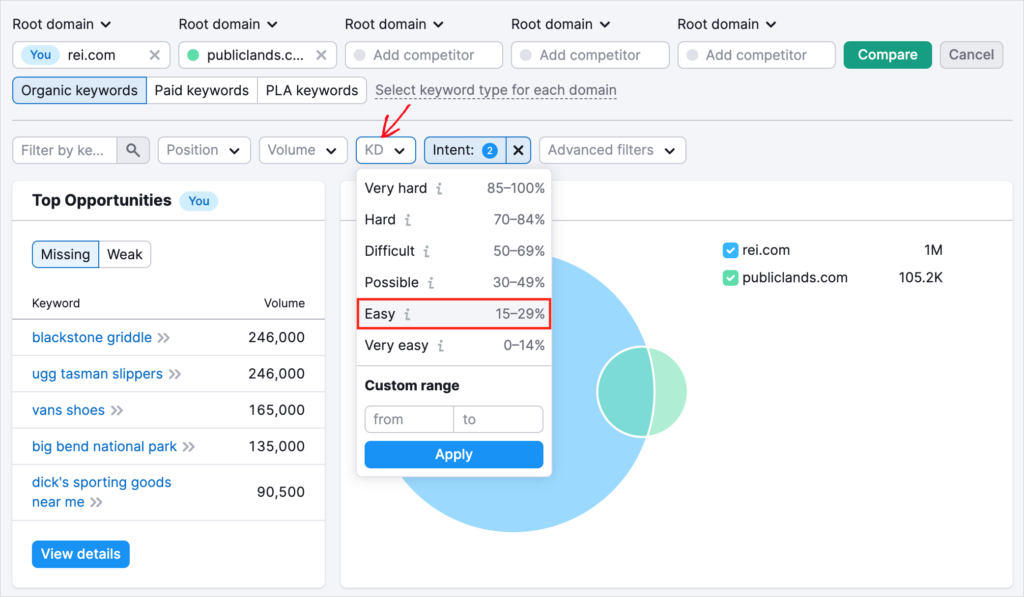
Now, scroll down to see your keyword list.
There are other ways to filter the list, but before we explore those, let’s get oriented.
Step 5: Get Oriented to the Keyword List
By default, the “Shared” option will display. This is a list of keywords that both you and your competitor are ranking for.
What are we seeing here?
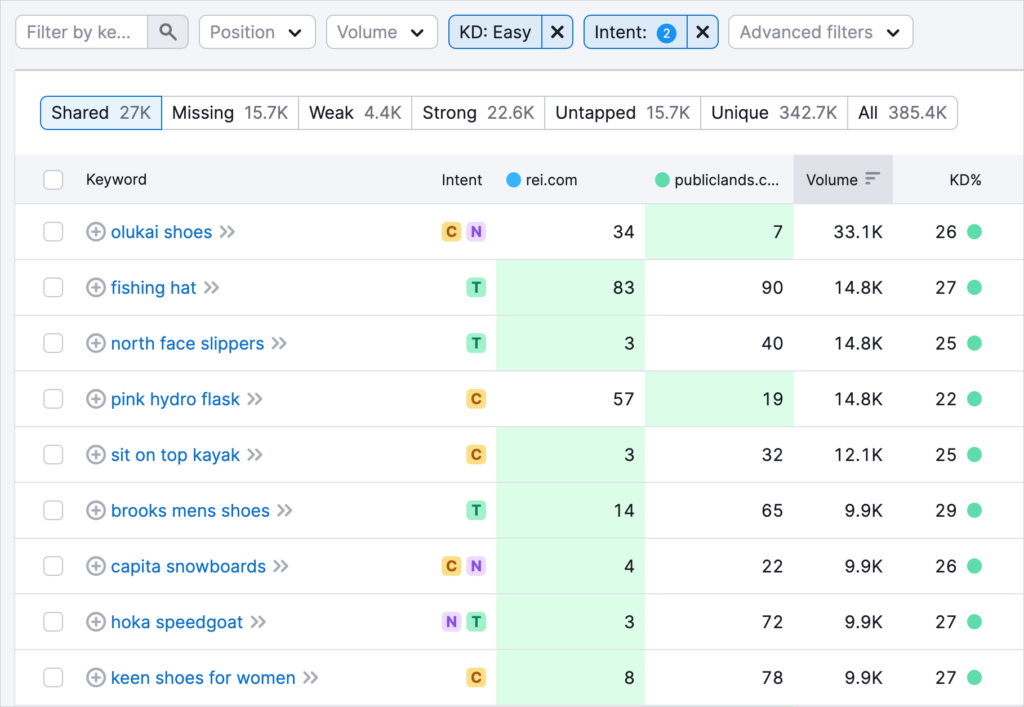
In the left column, in blue, we see the keywords that both REI.com and PublicLands.com are ranking for.
These include:
- Olukai shoes
- Pink hydro flask
- North Face slippers
(There are many more keywords you can scroll through.)
Keyword intent: The 2nd column displays the keyword intent. Remember: we filtered so we only see keywords with “C” (commercial) and “T” (transactional) intent.
Realize that some keywords are rated for more than one intent. That’s why you may see a “T” combined with an “N” (or “navigational”), for example,
Keyword rankings: The next 2 columns display the position that either REI or Public Lands is ranking in for that keyword.
For example, we can see that REI is ranking #1 for “hiking boots” and “hiking shoes.”

Search volume: In the next column, we see Search Volume (the estimated number of monthly searches for that keyword.)
Keyword difficulty (KD): And then there’s KD or Keyword Difficulty score.
While there are additional columns to the right of KD, we’ll stick with these for our keyword gap analysis.
The columns to the right of KD display advertising metrics, including CPC/PPC and keyword density in ads data.
Step 5: See What Your Competitor is Ranking #1 For
Next, let’s click the top of the 4th column: the PublicLands.com column. This action will sort the list by keywords that PublicLands.com is ranking highest for.

For starters, we see that PublicLands.com is ranking #1 for:
- Alpine design boulder co
- Alpine design men’s duck boots
- Dbx life jacket reviews
Remember to look to the left of the PublicLands.com column to see how REI.com ranks.
To find more information on a keyword, simply click on it. We click on “alpine design men’s duck boots.” As we saw in our keyword gap analysis, the keyword difficulty score is 21%, described on this page as “Easy.”
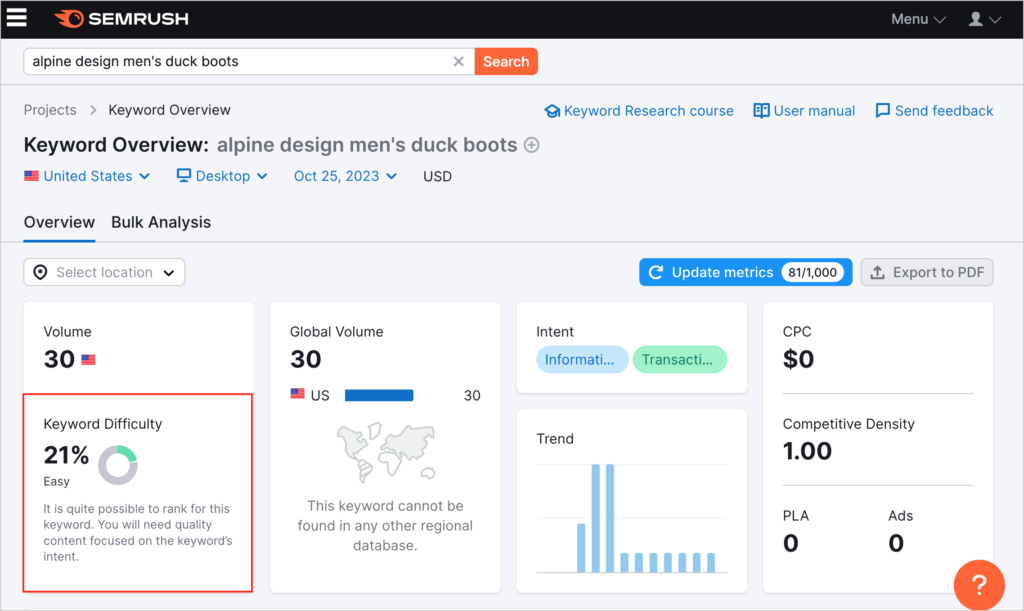
We want to scroll down to see who else occupies the top-ranking positions for this keyword.
Turns out Dick’s Sporting Goods and PublicLands occupy the top 3 positions in Google search results for “alpine design men’s duck boots.”
For our tutorial, let’s imagine that REI sells Alpine Design Men’s Duck Boots and wants to rank above the fold on page #1 of Google results so they can sell more of these boots online.
REI would then target this keyword, hoping to dislodge its competitors from 1 of the 3 top spots.
To target the keyword, they might:
- Improve the product page and seek more reviews.
- Publish a detailed review of the boots with a “Buy” button near the top.
Many website visitors do not scroll down a page. So it’s vital to include your CTA (call-to-action) link in the topmost portion of the web page.
Step 6: Select Keywords to Target
After browsing the keyword gap analysis results, choose a batch of keywords to start working on.
Remember, if you’re already ranking but not as high as your competitor, your approach will be to improve your existing page.
If you don’t have any rankings because you haven’t covered the topic, then you’ll create content from scratch.
Here are some examples of keywords that REI.com could choose to target based on a keyword gap analysis.
| Keyword | REI ranking | PublicLands ranking | Keyword Difficulty |
|---|---|---|---|
| Flat kayaks | 8 | 3 | Easy |
| Clothes for ice climbing | 26 | 3 | Very easy |
| GT pro aggressor | 13 | 3 | Easy |
| Vans ultra-range hiking | 9 | 3 | Easy |
| MTE boots | 26 | 4 | Easy |
| Sit-in kayak | 12 | 3 | Possible |
| Tent finder | 9 | 3 | Easy |
Remember, anything ranked #11 or higher is on “page 2” of Google search results.
Because the above-the-fold portion of page 1 of Google search results gets the majority of clicks, it’s worth moving up from #8 or #9.
You can tick the box to the left of keywords to select them and export them to a CSV or Excel file or as a PDF.
Additional Filtering Ideas
If you have a competitor that offers the same product as you (such as a software company that offers a competing solution to yours), you’ll want to use the Untapped filter.
This filter will show you keywords your competition is ranking for but which you have zero rankings for.
Again, to gain a quick edge, target keywords that are easy to rank for and have commercial or transactional intent.
And keep in mind that high-quality content is the most critical ranking factor.
Rank Higher With On-Page SEO
Once you’ve chosen a set of keywords to target and either updated your existing content or created new content for them, it’s crucial to optimize that content for SEO.
This is where an SEO plugin like All in One SEO (AIOSEO) comes in.
All in One SEO will analyze your page content and show you how to improve it for better ranking.
Optimize Your Pages With AIOSEO
After you download and install All in One SEO (AIOSEO), a setup wizard will walk you through a few short steps.
Then, while you’re logged into WordPress, navigate to any page you want to optimize.
All in One SEO (AIOSEO) will appear as a sidebar to the right of your editing pane.
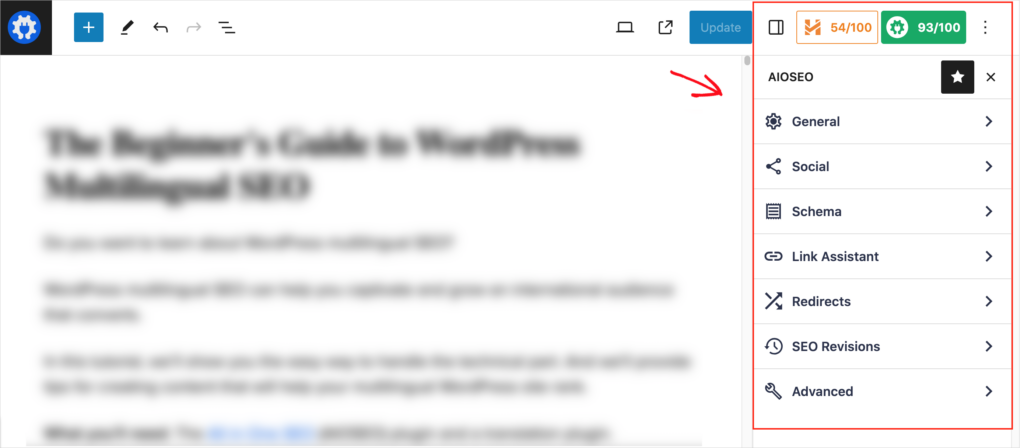
Click on General to see categories for optimizing.

These include:
- Focus Keyphrase
- Basic SEO
- Title
- Readability
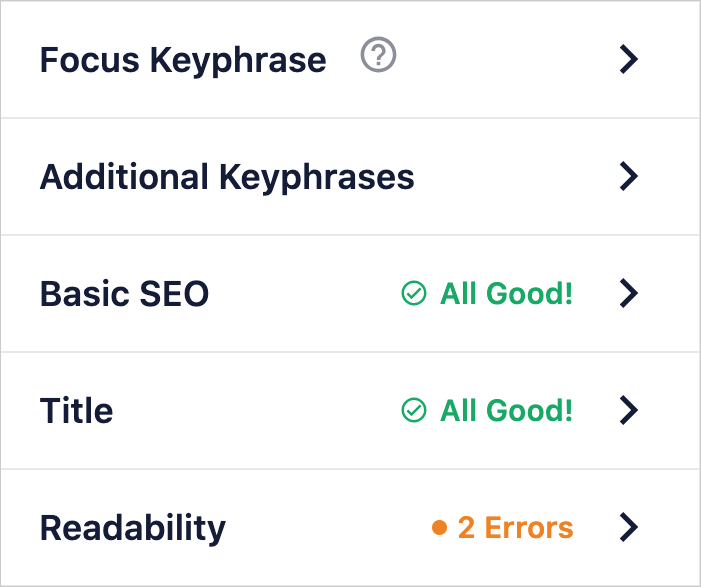
Click on any of those tabs to see what you’re doing well.
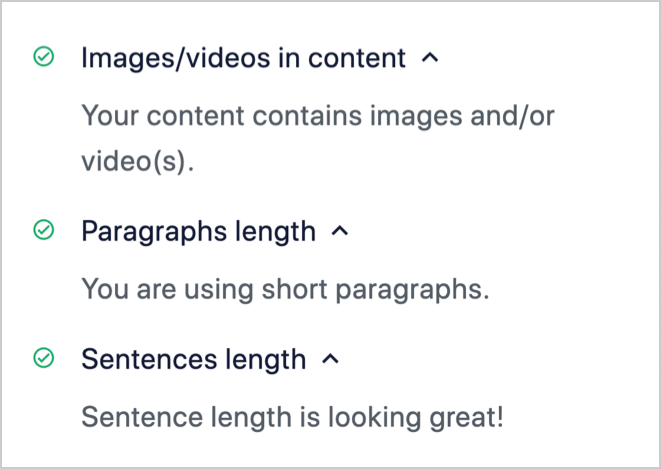
And what could use some improvement.

All in One SEO is an established plugin with thousands of 5-star reviews on WordPress.org. Currently, over 3 million site owners are using the plugin.
Beyond SEO Basics
In addition to the above checks, AIOSEO provides the following tools to help you rank higher, including the following.
- Schema Generator: This tool makes it easy to turn your page into a rich snippet, so it gets more traffic.
- Local SEO: Small businesses benefit from applying special schema markup to their pages. Fill out your business information, and AIOSEO will handle this for you.
- Link Assistant: Adding internal links is one of the most overlooked SEO tactics. And it can have a profound and near-immediate impact on the performance of your most important pages. Link Assistant makes adding internal links easy.

Q&A on Keyword Gap Analysis
What is a keyword gap vs. content gap?
Keyword gap analysis and content gap analysis are often used interchangeably, but the latter may extend far beyond keywords. For instance, content gap analysis can take into account broadcast and print media, as well as ebooks and other content forms.
How does competition impact keyword difficulty scores?
When prominent websites, like those of news organizations or governments, rank high for a keyword, it’s more difficult for lesser-known sites to rank. Keyword difficulty scores reflect the prominence of sites ranking high for that keyword.
The number of quality backlinks a ranking site has can play into keyword difficulty scores, but it’s essential to know that Google prioritizes quality content above all other factors. For this reason, a relatively unknown site can break into the rankings populated by established players.
Is it necessary to choose keywords with high search volume?
Should you only target high-volume keywords? The answer, as with so many marketing questions, is “It depends.” Long-tail keywords (i.e., specific keywords) often have lower search volume than vague keywords. And yet vague keywords often lack any buying intent.
Vague, broad keywords (short-tail keywords) are typically challenging to rank for. Ranking can be impossible or take so many resources that it drives up the cost of customer acquisition.
For these reasons, keyword intent is vital. By focusing primarily on commercial and transactional keywords, you’re targeting a qualified audience instead of people with no buying intent. But among the possible commercial or transactional keywords, you can look for those with the highest search volume.
How do you conduct a keyword gap analysis in Ahrefs?
In Ahrefs, you can conduct a keyword gap analysis by clicking “Content gap” in the left-hand navigation column. Follow the same process described on this page for keyword gap analysis.
With Ahrefs, you can compare URLs other than just root domains. For instance, you can compare your blog to your competitors’ blogs. You can also filter to discover why a competitor’s blog post on the same topic might rank better than yours. For example, perhaps they covered 2 subtopics that you missed.
To learn more, watch the video on the Ahrefs Content Gap feature.
Apart from doing a keyword gap analysis, how can I find relevant keywords to create content on?
To find relevant keywords to create content on, we recommend reading SEO Secrets the Pros Use to Grow Revenue and Keyword Difficulty: What Is It and How to Use It. These articles will explain search intent and show you how to pick keywords worth creating content on.
Competitive analysis: Use AIOSEO’s free SEO Analyzer to analyze a competitor’s website. Or use the SEO Analysis feature in the plugin to compare your site to theirs.
After Keyword Gap Analysis
Now that you’ve learned how to do a keyword gap analysis, what can you learn next? Move forward with intelligent content marketing strategies that increase market share.
Review our Keyword Research guide. Steal the SEO secrets pros use to grow revenue. Discover how to unseat rivals with topic clusters. And explore these competitive SEO strategies to help your small business rank.
While you’re improving your keyword strategy and increasing organic search traffic to your site, don’t forget to plan for conversions.
Find new opportunities for learning on our YouTube Channel. And follow us on X (Twitter), LinkedIn, or Facebook to stay in the loop.
Disclosure: Our content is reader-supported. This means if you click on some of our links, then we may earn a commission. We only recommend products that we believe will add value to our readers.
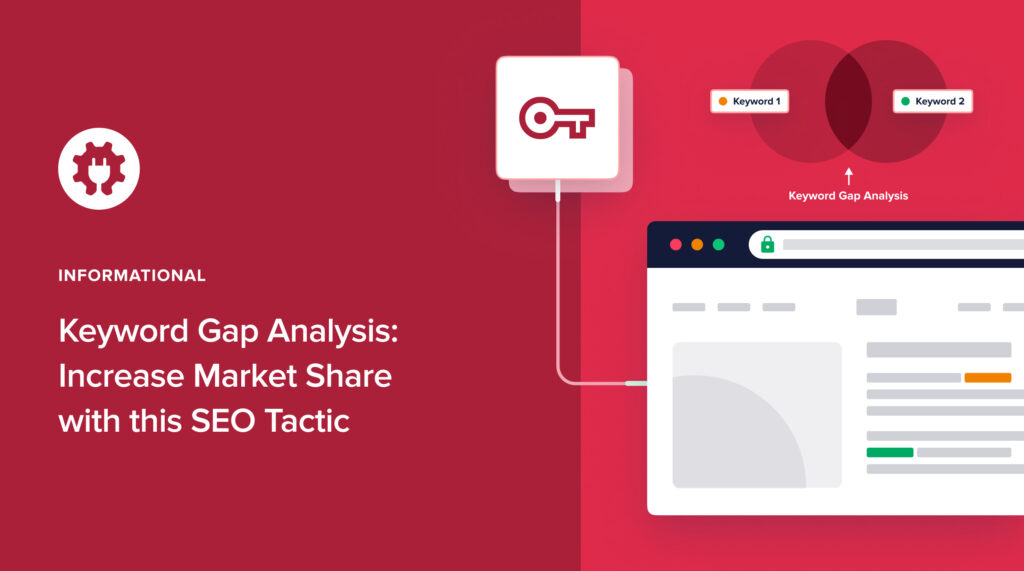

Lucid as always. Thanks for filling some of my SEO knowledge gaps.